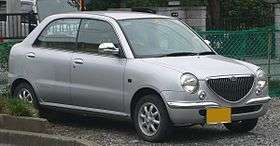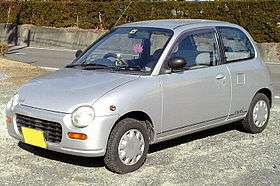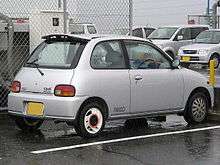Daihatsu Opti
| Daihatsu Opti | |
|---|---|
 | |
| Overview | |
| Also called | Daihatsu Opti Classic |
| Production | 1992-2002 |
| Powertrain | |
| Engine | 659 cc petrol |
| Chronology | |
| Predecessor | Daihatsu Leeza |
| Successor | Daihatsu Esse |
The Daihatsu Opti is a kei car produced by Japanese automaker Daihatsu from 1992 to 2002. It is available with a 659 cc petrol engine and either front- or four-wheel drive. It is a better equipped variant of the Daihatsu Mira. The Opti name refers to both "optimistic" and "optimum."[1]
First generation
| Daihatsu Opti (first generation) L300S | |
|---|---|
 | |
| Overview | |
| Production | 1992-1998 |
| Body and chassis | |
| Body style | 3-door and 5-door hatchback |
| Related | Daihatsu Mira L200 |
| Powertrain | |
| Engine | |
| Transmission |
3- or 4-speed automatic 5-speed manual |
| Dimensions | |
| Wheelbase | 2,280 mm (89.8 in) |
| Length | 3,295 mm (129.7 in) |
| Width | 1,395 mm (54.9 in) |
| Height | 1,395 mm (54.9 in) |
| Curb weight | 660 kg (1,455 lb) |

The first generation Daihatsu Opti code named L300S was launched in Japan in January 1992, after having been previewed at the 1991 Tokyo Motor Show as the "Daihatsu X-409".[2] The round appearance was conceived around a "ultra lovely" theme and was aimed at female buyers. Specifications were also higher than usual in the Kei class, with ample sound insulation and additional rust protection. All models originally came with a fuel injected, single-cam, four-valve straight-three with 55 PS (40 kW). The Opti was built on the L200 chassis of the Daihatsu Mira. It was available as a three-door hatchback and replaced the Daihatsu Leeza; an electrically operated Canvas Top was also available. A 4WD model (Aℓ-4) was also available (L310). In September 1992 the Ox, Ax, and Aℓ-4 trim levels were joined by the low-priced Ad, the somewhat sportier Ad-S, and the luxurious Ad-I which also has a driver's side airbag.[3] The Ad model got a two-valve version of the EF engine with 42 PS (31 kW).
In December 1992 the Opti Club Sport arrived, a version with 13-inch aluminium wheels, sports suspension, and a MOMO steering wheel, only available in metallic black. The Club Sport was also featured in Gran Turismo 2. In August 1993 a five-door variant arrived, as well as the lower-priced Pico model. In May 1994 the Pico S was introduced; this version combined the Pico specifications with the sporting additions of the Club Sport. Three-door automatics were upgraded to a four-speed unit. In February 1995 the Opti sticker on the right side of the bonnet was replaced with a centrally placed shield logo. At the same time the Parco special edition, equipped with a roof spoiler, was introduced. In October the SOHC 12-valve EF-EL engine was replaced with a DOHC version (EF-ZL), which also equipped the new Pico Limited. The Canvas Top option was discontinued. In May 1996 the retro Opti Classic model was introduced, featuring an eye-catching chrome grille and various other detail touches including leather trim pieces inside. A driver's side airbag also became standard across the range, reflecting new regulations. In May 1997 the front bumper and taillights were changed, with the rectangular grille replaced by an opening shaped like a sad mouth. The Classic was also changed cosmetically and the chromed Classic emblem was no longer mounted on the bonnet. In August 1997 the Club Sport model was reintroduced as a permanent member of the lineup (FF or 4WD) - still a sporty three-door with MOMO touches, it was now based on the Classic model. In December 1997 the Parco Classic limited edition was introduced. In November 1998, as kei car regulations were changed, the Opti L300 was replaced by the second generation.
YM Mobilemates ami
YM Mobilemates, a branch of Yamaha Motor Company, announced to produce the ami, a micro coupé with a Ferrari F40 inspired design.[4] The ami was a variant of the Opti fitted with a dummy mid-engine design body. It came with the same engine as the Opti, an SOHC or DOHC 12-valve 55 PS engine.[5] It cost from 2,150,000 to 2,545,000 yen, which equaled the cost of three standard Opti cars. 600 were planned to be produced but it was said that only three were ordered. The ami was only sold in Japan's capital area via an event ticket supplier called Ticket Pia.[4]
Second generation
| Daihatsu Opti (second generation) | |
|---|---|
|
| |
| Overview | |
| Production | 1998-2002 |
| Body and chassis | |
| Body style | 4-door saloon |
| Related | Daihatsu Mira L500 |
| Powertrain | |
| Transmission |
3- or 4-speed automatic 5-speed manual |
| Dimensions | |
| Wheelbase | 2,360 mm (92.9 in) |
| Length | 3,395 mm (133.7 in) |
| Width | 1,475 mm (58.1 in) |
| Height | 1,405 mm (55.3 in) |
| Curb weight | 740 kg (1,631 lb) |
The second-generation Daihatsu Opti was launched in Japan in November 1998. It was based on the modified L500 chassis from Daihatsu Mira. It was available as a four-door saloon in two different styles - Opti and Opti Classic (launched in 2000). It was discontinued in 2002, but was not replaced until 2005, by the Daihatsu Esse. The high-performance model, called the Opti Aerodown Beex, was only sold in Japan.
References
- ↑ 自動車ガイドブック [Japanese Motor Vehicles Guide Book 1992~'93] (in Japanese), 39, Japan: Japan Automobile Manufacturers Association, 1992-10-26, p. 244, ISBN 4-915220-39-7
- ↑ Automobile Guide Book 1992~'93, p. 159
- ↑ Biono, Adhi (1992-11-02). "Model baru Daihatsu" [New Daihatsu models]. Intan Motor (in Indonesian). Vol. VI no. 113. Jakarta: Yayasan Beraya Press. p. 38. ISSN 0215-7713.
- 1 2 "MEGA Rare 1997 (Daihatsu Opti-based) Yamaha AMI". WasabiCars. 14 June 2014. Retrieved 17 June 2014.
- ↑ "Honey, Someone shrunk the F40". FaezClutchless. 3 October 2012. Retrieved 17 June 2014.
External links
| Wikimedia Commons has media related to Daihatsu Opti. |
« previous — Daihatsu road vehicle timeline, 1990s–present | ||||||||||||||||||||||||||||||||||||
|---|---|---|---|---|---|---|---|---|---|---|---|---|---|---|---|---|---|---|---|---|---|---|---|---|---|---|---|---|---|---|---|---|---|---|---|---|
| Type | 1990s | 2000s | 2010s | |||||||||||||||||||||||||||||||||
| 0 | 1 | 2 | 3 | 4 | 5 | 6 | 7 | 8 | 9 | 0 | 1 | 2 | 3 | 4 | 5 | 6 | 7 | 8 | 9 | 0 | 1 | 2 | 3 | 4 | 5 | 6 | ||||||||||
| Kei car | Mira/Cuore | Mira/Cuore | Mira/Cuore | Mira/Cuore | Mira/Cuore/Charade | |||||||||||||||||||||||||||||||
| Naked | Esse | Mira e:S | ||||||||||||||||||||||||||||||||||
| Leeza | Mira Gino | Mira Gino/Trevis | Mira Cocoa | |||||||||||||||||||||||||||||||||
| Opti | Opti | Tanto Exe | ||||||||||||||||||||||||||||||||||
| Move | Move | Move | Move | Move | ||||||||||||||||||||||||||||||||
| MAX | Sonica | |||||||||||||||||||||||||||||||||||
| Tanto | Tanto | |||||||||||||||||||||||||||||||||||
| Wake | ||||||||||||||||||||||||||||||||||||
| Subcompact car | Mira Gino 1000 | Ayla | ||||||||||||||||||||||||||||||||||
| Charade | Charade | Ceria | Charade | |||||||||||||||||||||||||||||||||
| Storia/Sirion | Boon/Sirion | Boon/Sirion | Boon | |||||||||||||||||||||||||||||||||
| Compact car | Applause | |||||||||||||||||||||||||||||||||||
| Mid-size car | Altis | Altis | Altis | Altis | ||||||||||||||||||||||||||||||||
| Sports car | Leeza Spider | Copen | Copen | |||||||||||||||||||||||||||||||||
| Mini MPV | YRV | Coo/Materia | ||||||||||||||||||||||||||||||||||
| Boon Luminas | Sigra | |||||||||||||||||||||||||||||||||||
| Pyzar/Gran Move | Pyzar/Gran Move | Xenia | Xenia | |||||||||||||||||||||||||||||||||
| Mini SUV | Rocky/Feroza/Sportrak | Rocky/Feroza/Sportrak | ||||||||||||||||||||||||||||||||||
| Terios/Taruna | Be-go/Terios | |||||||||||||||||||||||||||||||||||
| Terios Kid | ||||||||||||||||||||||||||||||||||||
| Compact SUV | Rugger/Fourtrak/Taft | Rugger/Fourtrak | ||||||||||||||||||||||||||||||||||
| Kei truck/Microvan | Hijet | Hijet | Hijet | Hijet | ||||||||||||||||||||||||||||||||
| Midget II | ||||||||||||||||||||||||||||||||||||
| MUV/Light commercial vehicle | Delta Van | Delta Van | Zebra | |||||||||||||||||||||||||||||||||
| Delta | Delta | Delta | ||||||||||||||||||||||||||||||||||
| Atrai 7 | ||||||||||||||||||||||||||||||||||||
| Hijet Gran Cargo/Extol | Gran Max | |||||||||||||||||||||||||||||||||||
| Luxio | ||||||||||||||||||||||||||||||||||||